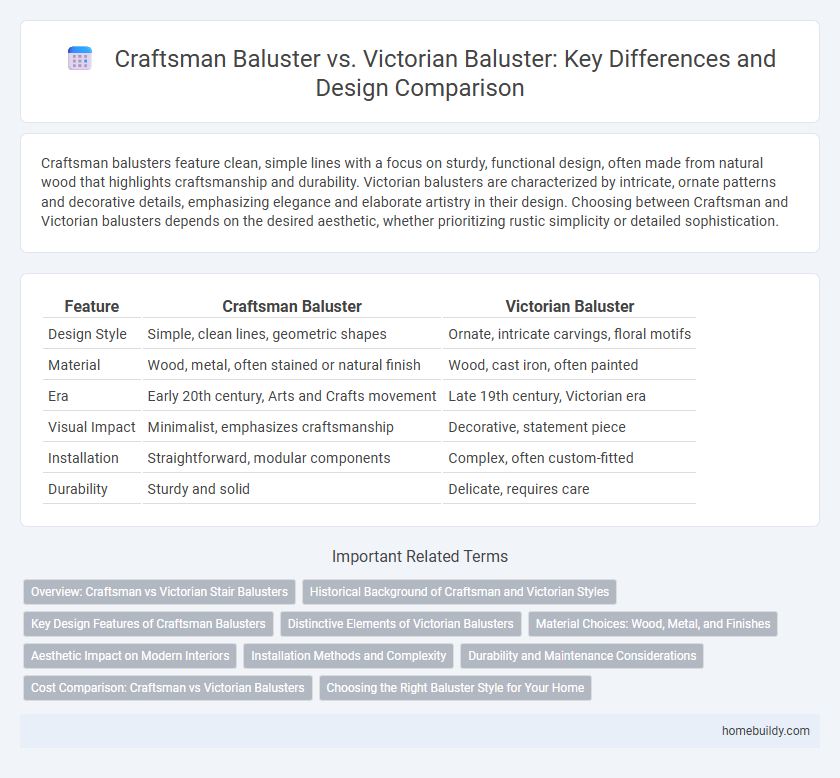Craftsman balusters feature clean, simple lines with a focus on sturdy, functional design, often made from natural wood that highlights craftsmanship and durability. Victorian balusters are characterized by intricate, ornate patterns and decorative details, emphasizing elegance and elaborate artistry in their design. Choosing between Craftsman and Victorian balusters depends on the desired aesthetic, whether prioritizing rustic simplicity or detailed sophistication.
Table of Comparison
| Feature | Craftsman Baluster | Victorian Baluster |
|---|---|---|
| Design Style | Simple, clean lines, geometric shapes | Ornate, intricate carvings, floral motifs |
| Material | Wood, metal, often stained or natural finish | Wood, cast iron, often painted |
| Era | Early 20th century, Arts and Crafts movement | Late 19th century, Victorian era |
| Visual Impact | Minimalist, emphasizes craftsmanship | Decorative, statement piece |
| Installation | Straightforward, modular components | Complex, often custom-fitted |
| Durability | Sturdy and solid | Delicate, requires care |
Overview: Craftsman vs Victorian Stair Balusters
Craftsman stair balusters emphasize simplicity and robust, clean lines inspired by the Arts and Crafts movement, typically featuring square or rectangular shapes made from wood or metal. Victorian stair balusters are characterized by ornate detailing and intricate designs, often crafted from turned wood or cast iron, reflecting the elaborate aesthetic of the 19th century. Choosing between Craftsman and Victorian balusters impacts the overall style of a staircase, with Craftsman offering a modern rustic appeal and Victorian providing a decorative, historic charm.
Historical Background of Craftsman and Victorian Styles
Craftsman balusters originated in the early 20th century during the American Arts and Crafts movement, emphasizing simplicity, handcrafted woodwork, and natural materials to reflect functional beauty. Victorian balusters date back to the mid-to-late 19th century, characterized by ornate designs, intricate carvings, and elaborate details that showcase the era's fascination with decorative elegance. The historical background of these styles highlights Craftsman's focus on artisanal craftsmanship and straightforward forms, contrasting with Victorian's rich ornamentation and architectural grandeur.
Key Design Features of Craftsman Balusters
Craftsman balusters emphasize simplicity and sturdiness with clean, straight lines and minimal ornamentation, often crafted from wood to highlight natural grain and texture. Their square or rectangular profiles contrast with the ornate, curved shapes typical of Victorian balusters, reflecting the Arts and Crafts movement's focus on functionality and handcrafted quality. The robust, geometric design of Craftsman balusters integrates seamlessly into rustic and traditional staircases, enhancing architectural authenticity and durability.
Distinctive Elements of Victorian Balusters
Victorian balusters feature ornate, intricate carvings and turned spindle designs that showcase craftsmanship with floral and geometric motifs, contrasting sharply with the simpler, rectilinear lines of Craftsman balusters. The use of rich, dark woods and elaborate detailing in Victorian balusters emphasizes elegance and grandeur common in 19th-century architecture. These distinctive elements create a visually striking, decorative appeal that highlights historical authenticity and artistic sophistication.
Material Choices: Wood, Metal, and Finishes
Craftsman balusters primarily utilize natural wood such as oak, maple, and cherry, emphasizing sturdy, straightforward designs with matte or satin finishes to highlight the wood grain. Victorian balusters often feature intricate metalwork crafted from wrought iron or brass, complemented by glossy or painted finishes that enhance their decorative complexity. Both styles offer customization in material choices, with Craftsman favoring durability and natural aesthetics, while Victorian prioritizes ornamental elegance and elaborate surface treatments.
Aesthetic Impact on Modern Interiors
Craftsman balusters offer clean lines and simple geometric shapes, complementing modern interiors with their understated elegance and focus on natural materials. Victorian balusters, rich in intricate detailing and ornate patterns, introduce a sense of historical charm and decorative complexity that can create striking focal points in contemporary spaces. Choosing between the two affects the overall aesthetic by balancing minimalist modern design against elaborate traditional craftsmanship.
Installation Methods and Complexity
Craftsman balusters typically feature simple, straight lines that allow for straightforward installation using basic mounting hardware and pre-drilled holes, making the process efficient and less time-consuming. Victorian balusters, characterized by intricate carvings and ornate details, require more precise installation techniques, often necessitating customized fittings or additional support to maintain structural integrity and aesthetic alignment. The complexity of Victorian baluster installation often demands professional expertise to ensure secure attachment and preservation of the decorative elements, contrasting with the more DIY-friendly Craftsman style.
Durability and Maintenance Considerations
Craftsman balusters, made from solid hardwood or metal, offer superior durability and require minimal maintenance compared to Victorian balusters, which often use intricate woodwork prone to wear and damage. The simpler design of Craftsman balusters reduces dust accumulation and eases cleaning, while Victorian balusters demand frequent touch-ups to preserve their ornate detailing. Choosing Craftsman balusters is ideal for long-lasting strength and low upkeep in stair railing systems.
Cost Comparison: Craftsman vs Victorian Balusters
Craftsman balusters typically cost less than Victorian balusters due to their simpler, more geometric designs and use of readily available materials. Victorian balusters often require intricate detailing and custom craftsmanship, increasing both labor and material expenses. Homeowners choosing between the two should consider budget constraints alongside desired aesthetic complexity when comparing costs.
Choosing the Right Baluster Style for Your Home
Choosing the right baluster style for your home involves considering the architectural theme and interior design. Craftsman balusters typically feature simple, geometric lines and sturdy square shapes, complementing rustic and modern craftsman-style homes. In contrast, Victorian balusters showcase intricate, ornamental details with rounded shapes and decorative patterns, ideal for homes seeking a classic, elegant ambiance.
Craftsman baluster vs Victorian baluster Infographic

 homebuildy.com
homebuildy.com